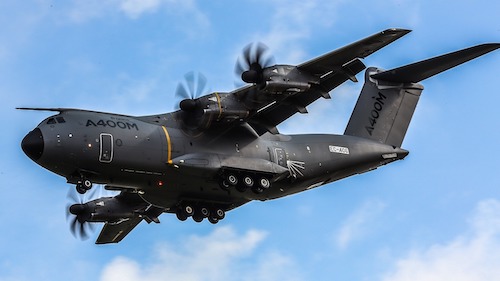A400M Atlas
Summary
| Category | Military Transport Aircraft |
| Origin country | 🇪🇺 Europe |
| Manufacturer | Airbus |
| First flight | 11 December 2009 |
| Year introduced | 2013 |
| Number produced | 174 units |
| Average unit price | $152 million |
Description
The A400M project originated from the Future International Military Airlifter (FIMA) group established in 1982 as a joint venture to develop a replacement for the C-130 Hercules and Transall C-160. Initial members were Aérospatiale, British Aerospace (BAe), Lockheed, and Messerschmitt-Bölkow-Blohm (MBB). Lockheed later withdrew, while Alenia of Italy and CASA of Spain joined, leading to the formation of Euroflag. The project explored various engine configurations before settling on a turboprop design requiring the development of a new engine. The Europrop TP400-D6 was selected in May 2003. The original partner nations—France, Germany, Italy, Spain, the United Kingdom, Turkey, Belgium, and Luxembourg—entrusted the Organisation for Joint Armament Cooperation (OCCAR) with managing the A400M acquisition. The first flight occurred on 11 December 2009 from Seville Airport, Spain, and EASA certification was received in March 2013.
The Airbus A400M provides enhancements in payload, range, internal volume, and operational capabilities. It can transport up to 37 tonnes. Its cargo box measures 17.71 meters long, 4.00 meters wide, and 3.85 to 4.00 meters high. It is equipped with a fly-by-wire flight control system utilizing sidestick controllers and flight envelope protection, with most systems based on the A380. The hydraulic system features dual 20.7 MPa channels. Electrical systems include dual-channel electrically powered hydraulic actuators and electrically/hydraulically powered hybrid actuators for enhanced protection against battle damage. Composite materials constitute more than 30 percent of the aircraft's structure, including the 42.4 meter wingspan primarily made of carbon fibre reinforced plastic. The aircraft is powered by four Europrop TP400-D6 engines, each rated at 8,250 kW, with counter-rotating propellers designed to enhance lift and reduce torque. It is also equipped with a forward-looking infrared enhanced vision system (EVS). It can be fitted with a removable refuelling probe and wing-mounted hose and drogue under-wing refuelling pods for aerial refueling operations.
While primarily designed for transport, the A400M can be configured for various mission roles, including tanker or medical evacuation. In its standard transport configuration, the A400M can carry a payload of up to 37 tonnes (41 short tons) over a range of 2,000 nmi (3,700 km; 2,300 mi). The internal cargo volume allows it to accommodate military equipment and vehicles, such as armored vehicles, missile systems, or helicopters.
Since its introduction, the Airbus A400M has been involved in a variety of operational roles. The French Air Force initiated the A400M's operational debut with a mission to Mali in December 2013, supporting Operation Serval. The RAF quickly established itself as a leading operator, accumulating flight hours and achieving high reliability early in the aircraft's service life. In 2017, A400Ms from France, Germany, and the UK participated in disaster relief efforts following Hurricane Irma in the Caribbean, delivering essential supplies and evacuating individuals. The German Luftwaffe employed the A400M in combat conditions for the first time in July 2018, transporting soldiers to Afghanistan. It has been used extensively in supply missions, notably by the French Air and Space Force for Operation Barkhane. In August 2021, several nations deployed A400Ms to assist in the Kabul Airport evacuations. In September 2023, an RAF A400M transported search and rescue teams to Morocco following an earthquake. The A400M's "mixed airdrop" capability was tested in October 2024, confirming its ability to deploy both personnel and cargo in a single sortie.
Main Variants:
-
A400M Grizzly: The designation for the five prototype and development aircraft used in the initial testing phase of the A400M program, plus one cancelled.
-
A400M-180 Atlas: The primary production variant of the A400M, representing the standard configuration delivered to customer nations.
Technical specifications
| Version: A400M Grizzly | |
|---|---|
| Crew | 2 pilots + 1 loadmaster + 1 optional |
| Operational range | 8,800 km (5,468 mi) |
| Maximum speed | 780 km/h (485 mph) |
| Wing area | 221.5 m² (2384.2 sqft) |
| Wingspan | 42.4 m (139.1 ft) |
| Height | 14.7 m (48.2 ft) |
| Length | 45.1 m (148.0 ft) |
| Service ceiling | 12,500 m (41,011 ft) |
| Empty weight | 66,500 kg (146,607 lbs) |
| Max. takeoff weight | 141,000 kg (310,851 lbs) |
| Takeoff distance | 1,150 m (3,773 ft) |
| Powerplant | 4 x turboprops MTU-Rolls-Royce TP400-D6 delivering 8203 kW each |
Current operating countries
| Country | Units | ||
|---|---|---|---|

|
Germany | 45 (+8) | |

|
France | 24 (+26) | |

|
United Kingdom | 21 | |

|
Spain | 14 (+13) | |

|
Turkey | 10 | |

|
Belgium | 7 | |

|
Malaysia | 4 | |

|
Luxembourg | 1 | |

|
Indonesia | 0 (+6) | |

|
Kazakhstan | 0 (+2) | |
All operators
